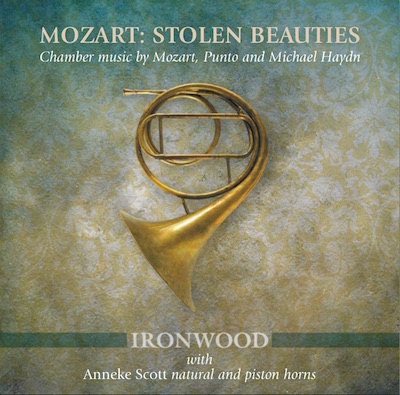
Anneke Scott and Ironwood, Mozart: Stolen Beauties, Chamber music by Mozart, Punto, and Michael Haydn (ABC Classics, 2014) . www.abcmusic.com
Ironwood personnel: Alice Evans & Julia Fredersdorff, violins, Nicole Forsyth & Heather Lloyd, violas, Daniel Yeadon, cello, Neal Peres Da Costa, pianoforte.
Instruments: Natural horn: Courtois Frère, Paris, c. 1835, with a detachable périnet valve set (sauterelle) by Antoine Halary, Paris, c. 1840; Violins: Mittenwald, 1750, and an 18th century Cremonese instrument; Violas: Thomas Dodd, London, 1820, and a Guarnarius copy built in 1998; Cello: William Forster II, London, c. 1780; Fortepiano: copy by D. Jacques Way, after Anton Walter, c. 1790
Anneke Scott is a natural horn player of the highest order. Her recent releases of works by Gallay are incomparable, and this recording lives up to the same standard. Mozart: Stolen Beauties is a delightful collection of works by Wolfgang Amadeus Mozart, Giovanni Punto, and Michael Haydn. Additionally, this recording features an incredibly demanding set of variations on Mozart’s “Là ci darem la mano” found among the music left behind by the Italian horn virtuoso Giovanni Puzzi. The composer of the variations remains unknown, but the piece gives us a wonderful snapshot of the virtuosity of Puzzi, a student of Luigi Belloli who greatly impressed Napoleon and then went on to become the foremost horn player in London during the first half of the 19th century.
Scott’s playing on this collection is sensitive throughout. Her articulations and tone quality consistently match the timbre of the other period instruments, from the velvety string sounds to the delicate sound of the fortepiano. There are many moments throughout the recording in which the strings and horns emulate each other’s portamentos with great ease.
Aside from the incredible set of variations that opens this recording, there are two very interesting presentations. One is an arrangement of Mozart’s “Kegelstatt” Trio (originally for clarinet, viola, and piano) set for horn, viola, cello, and piano. This Concertante setting was arranged by Barham Livius (1787–1865). Livius was a pupil of Giovanni Puzzi’s and a businessman in London, and similar to the variations on “Là ci darem la mano,” Livius’s arrangement was found in the folio of works left behind by Puzzi. The other pieces on this recording that are of particular interest are three movements from Giovanni Punto’s duets for horn and cello, especially since there may be no other recording available of these pieces on period instruments (at least as far as I am aware).
-- Eric Brummitt



